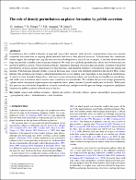| dc.contributor.author | Andama, G. | |
| dc.contributor.author | Ndugu, Nelson | |
| dc.contributor.author | Anguma, Simon Katrini | |
| dc.contributor.author | Jurua, Edward | |
| dc.date.accessioned | 2022-03-22T08:13:46Z | |
| dc.date.available | 2022-03-22T08:13:46Z | |
| dc.date.issued | 2022-01-28 | |
| dc.identifier.citation | Andama, G., Ndugu, N., Anguma, S., & Jurua, E. (2022). The role of density perturbation on planet formation by pebble accretion. arXiv preprint arXiv:2203.09266. | en_US |
| dc.identifier.uri | http://dir.muni.ac.ug/xmlui/handle/20.500.12260/450 | |
| dc.description.abstract | Protoplanetary discs exhibit a diversity of gaps and rings of dust material, believed to be a manifestation of pressure maxima commonly associated with an ongoing planet formation and several other physical processes. Hydrodynamic disc simulations further suggest that multiple dust ring-like structures may be ubiquitous in discs. In the recent past, it has been shown that dust rings may provide a suitable avenue for planet formation.We study how a globally perturbed disc affects dust evolution and core growth by pebble accretion. We performed global disc simulations featuring a Gaussian pressure profile, in tandem with global perturbations of the gas density, mimicking wave-like structures, and simulated planetary core formation at pressure minima and maxima. With Gaussian pressure profiles, grains in the inside disc regions were extremely depleted in the first 0.1 Myrs of disc lifetime. The global pressure bumps confined dust material for several million years, depending on the strength of perturbations. A variety of cores formed in bumpy discs, with massive cores at locations where core growth was not feasible in a smooth disc, and small cores at locations where massive cores could form in a smooth disc. We conclude that pressure bumps generated by a planet and/or other physical phenomena can completely thwart planet formation from the inside parts of the disc. While inner disc parts are most favourable for pebble accretion in a smooth disc, multiple wave-like pressure bumps can promote rapid planet formation by pebble accretion in broad areas of the disc. | en_US |
| dc.publisher | arXiv preprint | en_US |
| dc.subject | Planets and satellites:formation – planets and satellites | en_US |
| dc.subject | Physical evolution – planets and satellites | en_US |
| dc.subject | Gaseous planets – protoplanetary discs – hydrodynamics – stars | en_US |
| dc.subject | Formation | en_US |
| dc.title | The role of density perturbation on planet formation by pebble accretion | en_US |
| dc.type | Article | en_US |

